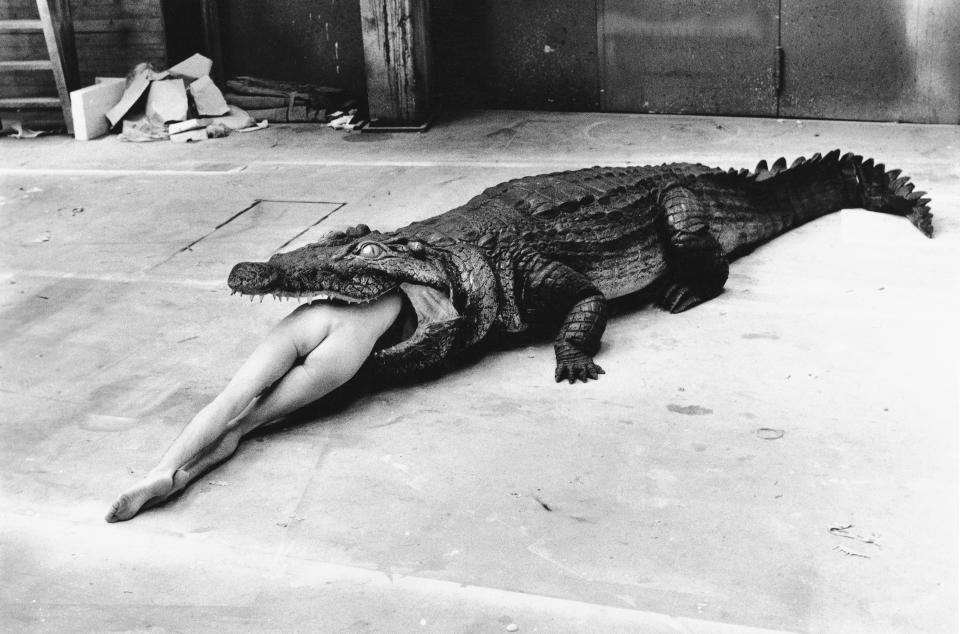‘Helmut Newton: The Bad and the Beautiful’ Review: Portrait of a Provocateur Who Worshiped Women

Click here to read the full article.
Perverse, erotic, debasing, and powerful, fashion photographer Helmut Newton’s photographs throughout the 20th century displayed a worship of women similar to a domineering male director and his female star. Fittingly, Newton is most famous in cinephile circles for a 1988 photograph he took in Los Angeles of David Lynch and his muse Isabella Rossellini, at the height of their “Blue Velvet” fame. In the black-and-white photo, the filmmaker fondles Rossellini’s face, looking into her soul not as a human being, but as a vessel for an idea. He’s a puppeteer, and she his puppet.
That’s very much how the German-Australian Newton perceived his mainly female subjects, and Gero von Boehm’s new documentary “Helmut Newton: The Bad and the Beautiful” spends the majority of its short, yet encompassing running time talking to those women, whom Newton clearly idolized. It’s a striking lineup of talking heads: Rossellini herself, Grace Jones, Charlotte Rampling, Claudia Schiffer, Marianne Faithfull, Hanna Schygulla, Nadja Auermann, and Anna Wintour, among others. While the things many of them were asked to do as objects of the Newton gaze seem extreme by today’s standards — often involving sadomasochistic acts of sexual expression and explicit, if tasteful, nudity — these women all adored him.
More from IndieWire
'Oliver Sacks: His Own Life' Trailer: The Legendary Thinker Gets the Documentary Treatment
'The Room' Review: Enter This Silly, Spooky 'Twilight Zone' Riff with Caution
, who died in a car crash in 2004 in front of, of all places, the starry Chateau Marmont in West Hollywood.
Born in Weimar-era Berlin, Newton came of age in Nazi-occupied Germany, with a fascination for women at a young age as relayed through several amusing stories: one where a barely adolescent Newton crashed into a fence while checking out a girl, another where he became persona non grata at a swimming hole after getting busted for undressing a woman in the water. The drama and expressionism of the Weimar era marked the best work of Newton’s career, often black-and-white, over-the-top, hilarious, and unsettling images, from a gorgeous model being swallowed whole by an alligator, to another making an unholy bond with a swan.
But arguably Newton’s biggest influence, he says in the film, was Leni Riefenstahl, the German director hired to create highly stylized Nazi propaganda that idealized white, blonde, athletic German bodies. To be clear, Newton, like Riefenstahl, never shot somebody who wasn’t beautiful. While Newton, and the rest of the world, came to understand the problematic roots of Riefenstahl’s compositions, he couldn’t deny their aesthetic prowess, and her eye cast a light over his work all his life.
Fashion houses knew what they were getting when they commissioned a Newton photo. “You’re not going to get a pretty girl on a beach,” Anna Wintour says in an interview. Instead, you were likely to get stark shots that blended pain and humor. Grace Jones says it took at least four phone calls for Newton to take her seriously, because he felt at first that her breasts were too small. Newton liked a voluptuous bosom. “He was a little bit of a pervert,” the Jamaican singer and model says. “But so am I.” His photos, especially those of Jones, had a playful eroticism but were never vulgar. (In a series of nudes he shot of Jones, her crotch is concealed by a perfectly placed sliver of a shadow.)
While Newton certainly treated the women he photographed as sexual objects and extensions of a vision of machismo, the models, at least according to the interviews presented here, never felt disrespected, even when he’s asking their male partners to grab their asses before the camera. Feminists disagreed. An amusing, tense TV interview from the archives finds activist Susan Sontag taking Newton to task. He’s more chuffed than offended, immune to whatever cancel culture might’ve looked like in the 1970s.

The documentary’s most heartfelt through-line traces Helmut’s adoring relationship with his wife, June Newton, who became an equal collaborator with her husband in the back half of his career. She recalls a time while convalescing in hospital after a major surgery, her abdomen sewn grotesquely up the middle, when Helmut asked her to throw off the bedsheet so he could get a closer look through the lens of his camera. Rather than shy away or faint as she thought he might, Helmut photographed her tenderly, capturing his wife in an abject moment of vulnerability. June felt this was the ultimate expression of their love for one another, even if it wasn’t present in other photos they took of each other.
Gero von Boehm’s film plays it straight, and doesn’t break the mold in terms of crafting a documentary that examines an artist’s life. With such a rich catalogue of daring, boundary-pushing work, the filmmakers might have had the chance to assemble a more cinematic portrait of Newton in the style of his photos. But “The Bad and the Beautiful” is mainly a talking-heads affair, an exploration of his career through the eyes and stories of those who lived it. While the film is hardly as transgressive as its subject, it manages to be unexpectedly moving, and a nostalgic time capsule of an art-world rebel whose unorthodox methods and decidedly politically incorrect vision couldn’t exist today.
Grade: B
“Helmut Newton: The Bad and the Beautiful” opens from Kino Lorber in participating virtual cinemas on Friday, July 24. Find out where to watch the film via Kino Marquee here.
Best of IndieWire
New Movies: Release Calendar for July 24, Plus Where to Watch the Latest Films
A Calendar of All the Movies That Would Have Been Released — and Their New Dates
Sign up for Indiewire's Newsletter. For the latest news, follow us on Facebook, Twitter, and Instagram.

